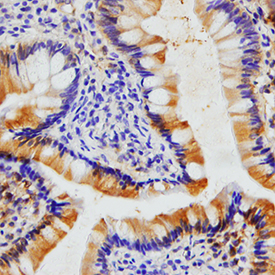Human CCL11/Eotaxin Antibody Summary
Gly24-Pro97
Accession # P51671
Applications
Human CCL11/Eotaxin Sandwich Immunoassay
Please Note: Optimal dilutions should be determined by each laboratory for each application. General Protocols are available in the Technical Information section on our website.
Scientific Data
 View Larger
View Larger
CCL11/Eotaxin in Human Colon. CCL11/Eotaxin was detected in immersion fixed paraffin-embedded sections of human colon using Mouse Anti-Human CCL11/Eotaxin Monoclonal Antibody (Catalog # MAB320) at 15 µg/mL for 1 hour at room temperature followed by incubation with the Anti-Mouse IgG VisUCyte™ HRP Polymer Antibody (Catalog # VC001). Tissue was stained using DAB (brown) and counterstained with hematoxylin (blue). Specific staining was localized to cytoplasm of epithelial and stromal cells. View our protocol for Chromogenic IHC Staining of Paraffin-embedded Tissue Sections.
 View Larger
View Larger
Chemotaxis Induced by CCL11/Eotaxin and Neutralization by Human CCL11/Eotaxin Antibody. Recombinant Human CCL11/Eotaxin (Catalog # 320-EO) chemoattracts the BaF3 mouse pro-B cell line transfected with mouse CCR3 in a dose-dependent manner (orange line). The amount of cells that migrated through to the lower chemotaxis chamber was measured by Resazurin (Catalog # AR002). Chemotaxis elicited by Recombinant Goat Anti-Human CCL11/Eotaxin (5 ng/mL) is neutralized (green line) by increasing concentrations of Mouse Anti-Human CCL11/Eotaxin Monoclonal Antibody (Catalog # MAB320). The ND50 is typically 1-5 µg/mL.
Reconstitution Calculator
Preparation and Storage
- 12 months from date of receipt, -20 to -70 °C as supplied.
- 1 month, 2 to 8 °C under sterile conditions after reconstitution.
- 6 months, -20 to -70 °C under sterile conditions after reconstitution.
Background: CCL11/Eotaxin
CCL11 is a potent eosinophil chemoattractant that was originally purified from bronchoalveolar lavage fluid of guinea pigs sensitized by aerosol challenge with ovalbumin. Microsequencing of the purified protein revealed the guinea pig CCL11 to be a member of the beta (CC) chemokine family of inflammatory and immunoregulatory cytokines. cDNA clones for guinea pig, mouse, and human CCL11 have been isolated. Human CCL11 cDNA encodes a 97 amino acid residue precursor protein from which the amino-terminal 23 amino acid residues are cleaved to generate the 74 amino acid residue mature human CCL11. At the protein sequence level, mature human CCL11 is approximately 60% identical to mature mouse and guinea pig CCL11. In addition, human CCL11 also shows high amino acid sequence identity to human MCP-1, 2, and 3. Human CCL11 is chemotactic for eosinophils, but not mononuclear cells or neutrophils. The CC chemokine receptor 3 (CCR3) has now been identified to be a specific human CCL11 receptor (1-3). CCR3 has also been shown to serve as a cofactor for a restricted subset of primary HIV viruses and binding of CCL11 to CCR3 inhibited infection by the HIV isolates (4).
- Kitamura, M. et al. (1996) J. Biol. Chem 271:7725.
- Garcia-Zepeda, E.A. et al. (1996) Nature Medicine 2:449.
- Ponath, P.D. et al. (1996) J. Clin. Invest. 97:604.
- Choe, H. et al. (1996) Cell 85:1135.
Product Datasheets
Citations for Human CCL11/Eotaxin Antibody
R&D Systems personnel manually curate a database that contains references using R&D Systems products. The data collected includes not only links to publications in PubMed, but also provides information about sample types, species, and experimental conditions.
9
Citations: Showing 1 - 9
Filter your results:
Filter by:
-
An initial investigation into endothelial CC chemokine expression in the human rheumatoid synovium.
Authors: Rump L, Mattey D, Kehoe O, Middleton J
Cytokine, 2017-09-01;97(0):133-140.
Species: Human
Sample Types: Whole Tissue
Applications: IHC-Fr -
The ageing systemic milieu negatively regulates neurogenesis and cognitive function.
Authors: Villeda SA, Luo J, Mosher KI, Zou B, Britschgi M, Bieri G, Stan TM, Fainberg N, Ding Z, Eggel A, Lucin KM, Czirr E, Park JS, Couillard-Despres S, Aigner L, Li G, Peskind ER, Kaye JA, Quinn JF, Galasko DR, Xie XS, Rando TA, Wyss-Coray T
Nature, 2011-08-31;477(7362):90-4.
Species: Mouse
Sample Types: Whole Cells
Applications: Neutralization -
Eotaxins and CCR3 interaction regulates the Th2 environment of cutaneous T-cell lymphoma.
Authors: Miyagaki T, Sugaya M, Fujita H
J. Invest. Dermatol., 2010-05-27;130(9):2304-11.
Species: Human
Sample Types: Whole Tissue
Applications: IHC-P -
Maternal and cord plasma cytokine and chemokine profile in pregnancies complicated by asthma.
Authors: Osei-Kumah A, Smith R, Clifton VL
Cytokine, 2008-07-17;43(2):187-93.
Species: Human
Sample Types: Plasma
Applications: ELISA Development -
Computed tomographic scan-diagnosed chronic obstructive pulmonary disease-emphysema: eotaxin-1 is associated with bronchodilator response and extent of emphysema.
Authors: Miller M, Ramsdell J, Friedman PJ, Cho JY, Renvall M, Broide DH
J. Allergy Clin. Immunol., 2007-11-01;120(5):1118-25.
Species: Human
Sample Types: Whole Tissue
Applications: IHC-P -
Increased expression of Th2-associated chemokines in bullous pemphigoid disease. Role of eosinophils in the production and release of these chemokines.
Authors: Gounni Abdelilah S, Wellemans V, Agouli M, Guenounou M, Hamid Q, Beck LA, Lamkhioued B
Clin. Immunol., 2006-06-16;120(2):220-31.
Species: Human
Sample Types: Blister Fluid, Cell Culture Supernates
Applications: ELISA Development, Neutralization -
The CC chemokine eotaxin/CCL11 has a selective profibrogenic effect on human lung fibroblasts.
Authors: Puxeddu I, Bader R, Piliponsky AM, Reich R, Levi-Schaffer F, Berkman N
J. Allergy Clin. Immunol., 2005-12-02;117(1):103-10.
Species: Human
Sample Types: Whole Cells
Applications: Neutralization -
Manipulation of host cytokine network by ticks: a potential gateway for pathogen transmission.
Authors: Hajnicka V, Vancova I, Kocakova P, Slovak M, Gasperik J, Slavikova M, Hails RS, Labuda M, Nuttall PA
Parasitology, 2005-03-01;130(0):333-42.
Species: Human
Sample Types: Saliva
Applications: ELISA Development -
Chemoattractant factors in breast milk from allergic and nonallergic mothers.
Authors: Bottcher MF, Jenmalm MC, Bjorksten B, Garofalo RP
Pediatr. Res., 2000-05-01;47(5):592-7.
Species: Human
Sample Types: Serum
Applications: ELISA Development
FAQs
No product specific FAQs exist for this product, however you may
View all Antibody FAQsReviews for Human CCL11/Eotaxin Antibody
Average Rating: 5 (Based on 2 Reviews)
Have you used Human CCL11/Eotaxin Antibody?
Submit a review and receive an Amazon gift card.
$25/€18/£15/$25CAN/¥75 Yuan/¥2500 Yen for a review with an image
$10/€7/£6/$10 CAD/¥70 Yuan/¥1110 Yen for a review without an image
Filter by:




